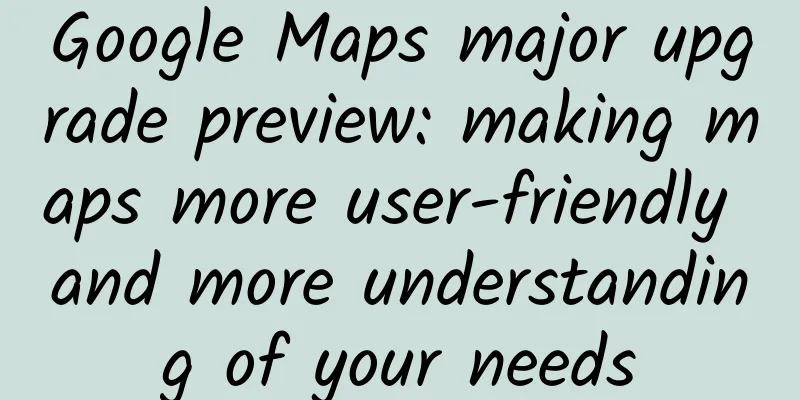Google Maps major upgrade preview: making maps more user-friendly and more understanding of your needs

|
At the I/O developer conference that opened early this morning, Google said that the Google Maps app will receive a bunch of feature updates in the coming months. First, the detailed street maps launched in August last year will enter 50 new cities such as Berlin, Sao Paulo, Seattle and Singapore by the end of this year. These maps show the location of sidewalks, crosswalks, and pedestrian islands, as well as the shape and width ratio of the road. This can help you choose the route that is most suitable for walking. In addition, Google Maps will become more user-friendly, highlighting the information that is important to you based on information such as the time of day and whether the user is traveling in an unfamiliar city, rather than showing all the information on the map at once. For example, if you open the map at 8 am, you will see a coffee shop instead of a dinner place. And if you are traveling, the map will show landmark buildings and tourist attractions. Secondly, Google is expanding the scope of busyness information. The feature currently just tells you how busy it is in a specific area. But in the future, you'll also get information about the busyness of the entire area, such as whether a neighborhood or part of a city is busier than usual. You can simply open the map and immediately see busy hotspots to avoid, or vice versa - look for the busiest spots and get an overview of lively neighborhoods at a glance.
If you're on foot and exploring a new neighborhood, you'll be able to access augmented reality Live View right from the map -- it'll pop up with directions. It'll also give you useful details about the shops and restaurants around you, like how popular they are, recent reviews and photos. For complex intersections, you'll get helpful new street signs so you know exactly which way you're on and which way to go. If you're traveling, Live View will show you where you are in relation to your hotel, making it easier to find your way back. Finally, Google wants to reduce hard braking, which is when you're approaching a busy intersection and traffic suddenly slows down, forcing you to slam on the brakes. According to research from the Virginia Tech Transportation Institute, these moments can be a leading indicator of a car's likelihood of a crash. So Google wants to make them a thing of the past. So "soon," Google Maps will use machine learning and navigation information to reduce the chances of you having to hard brake while driving. The app will give you the fastest route, potentially reducing the chances of you having to encounter a hard braking situation. If the ETA is the same as other routes, or the difference is very small, that route will be recommended. Google believes this change has the potential to eliminate 100 million hard braking events per year on routes driven using Google Maps. |
<<: Android Studio Arctic Fox (2020.3.1) Beta released, enabling a new version naming scheme
>>: It's about to get easier to change leaked passwords in Chrome for Android
Recommend
Tencent 360 Lenovo Xiaomi: Why choose them for Windows 10 distribution?
While the mobile Internet is swallowing up everyt...
The latest WeChat 8.0.15 version update adds four major changes
Coinciding with the National Day holiday, the off...
6 creative ways to use information flow advertising
Operations often complain about poor click-throug...
95% of entrepreneurs, CEOs and CPs don’t know about SEM promotion
"For any company, SEO and SEM will be import...
How much does it cost to attract investment for Jinchang’s flash sale mini program?
Jinchang Seckill Mini Program investment promotio...
How to improve user retention? These 3 methods are indispensable!
In this article, we will analyze how to keep acqu...
Tencent admits to being a coward for the first time. People who have been tortured by WeChat for many years finally get their revenge.
[[318009]] On March 9, Tencent’s WeChat made head...
Where have Apple fans gone? Will they come back?
Revenue contribution from Greater China fell to i...
Tianyu Cangqiong game gold-making project, claiming to have 50+ orders per day
Tianyu Cangqiong game gold-making project, claimi...
These 5 changes in iOS14 interaction are worth studying carefully
I have always liked the interactive design of the...
The tremendous power of B2B operations, from building a value chain to humanizing the carrying system!
After all fields of B2C have entered the red ocea...
What kind of convenience can store mini programs bring to consumers and businesses?
Traditional offline promotion methods generally c...
Anshan SEO training: the development direction of network promotion methods in the Internet + era
With the rapid development of the Internet and th...
Is it expensive to develop the Lhasa Pet Mini Program? Lhasa Pet Mini Program Investment Fees and Process
How much does it cost to attract investment in th...
In-depth article | What skills are needed to be an excellent event operator?
We call this group of people who "achieve go...





![Uncovering the magic number behind user growth [5]](/upload/images/67cc3598511d3.webp)



